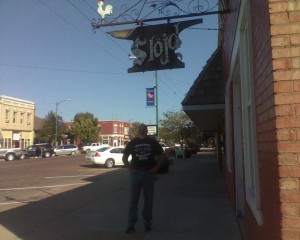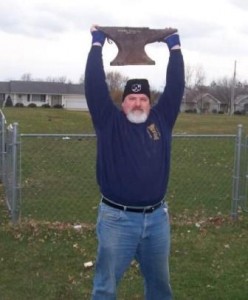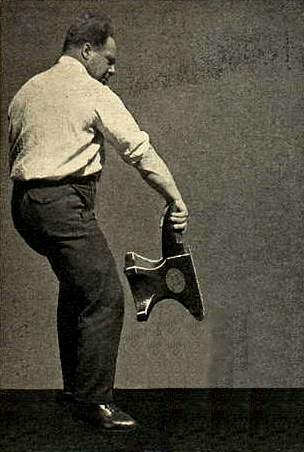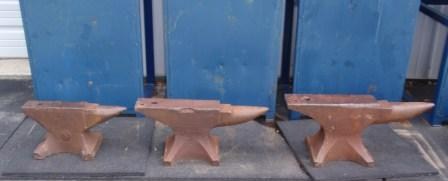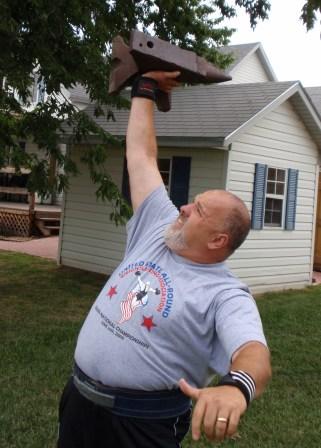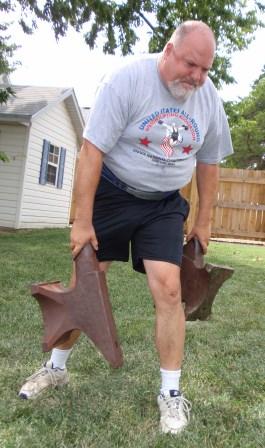New Orleans Anvil Lifting
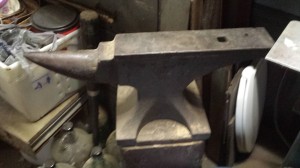
Columbian Anvil at Sigles Metal Shop in the French Quarter....it waited 57 years for me to come lift it!
by Thom Van Vleck
Recently a friend of mine said that every weightlifter is always secretly sizing up objects around him to see if he can lift them. I guess I do that to. Some you know are impossible, others not so impossible. I like to keep my eye out for Anvils. Most of you know my affinity for anvils, you can find an previous article I wrote on my own family anvil here:
This past month I was able to take my wife on a surprise trip to New Orleans. The choice to go there was almost chance. I had a credit to use, there was a deal on New Orleans……so there you go! We were just looking to spend some time sight seeing in the French Quarter. Now, everyone has heard of Bourbon Street, and it goes right through the middle of the French Quarter. But there is much more to it than that and my wife and I set about exploring the back streets checking out the unusual stores, bars, and shops. Some were “interesting” to say the least but I came across one place that was closed on that day that intrigued me. I was called Sigles Antiques and Metal Craft.
Sigles was a nondescript shop on Royal next to the Andrew Jackson Hotel. There is a story on the Jackson side of my family that we are related, but I can’t prove it. But my wife thinks his crusty, stubborn attitude pretty much proves we are related! Sigles had all kinds of iron work. Scroll work, hitching post tops, all kinds of stuff. A very elderly woman ran the shop who I later found out was 91. She said that she and her husband had owned the shop for 57 years. My wife bought some fluer-de-lei coat hangers and I found a nice spear top that I’m going to use for one of my Highland Games flags.
Then I noticed a shop door that said no customers in the shop. “SHOP”….I had to see the metal shop! I very politely asked the owner’s wife if I could check it out even if the husband wasn’t there. She graciously complied and it was like stepping back in time! All kinds of old tools….I mean really old stuff! And then….there it was….the Anvil. She had no idea about where it came from except it came with the shop when they bought it 57 years ago! I explained I liked to lift things and she gave me the go ahead. It was not fixed to the stand and it was fairly easy, I would guess it around 150lbs. I then took some photos so I could learn more about it and promised to share that with her as she was curious herself!
The Anvil had what looked to be a “V” or inverted pyramid and a large “M” on the other side. I did some research and found out this was a historically significant anvil. It was a “Columbian” which were manufactured in Cleveland, Ohio from about 1903 to 1925. They were the first anvils to be “Cast Steel” in one solid piece. Evidently this made them very tough compared to the “Wrought Iron” Anvils made before that were welded from pieces into one Anvil. They were very popular in their time and while the “Cast” or “tool” or “Crucible” type steel was very expensive it required less labor to finish and it was around this time labor was becoming more expensive than materials so they really took off. This particular Anvil is of the “London Pattern” and it would be valued at 2-4 bucks a pound….but to me it’s priceless! They made these from 10lbs to 800lbs in increments and in 1925 or 26 the company quit making them and imported a like cast steel anvil from Sweden. I wonder if it’s the same steel foundry that makes Eleiko! (or made Eleiko as I hear they get their product from China now….).
I have work trip that takes me back in September. I plan to share what I learned and visit the shop again. These folks live above their shop and are in their 90’s and have no plans to retire. I think that’s pretty cool and….as far as she knows….NOBODY had lifted that anvil overhead before! My wife said, “Leave it to you to find something to lift in the French Quarter”. Yes, I’m always looking for something to lift!
